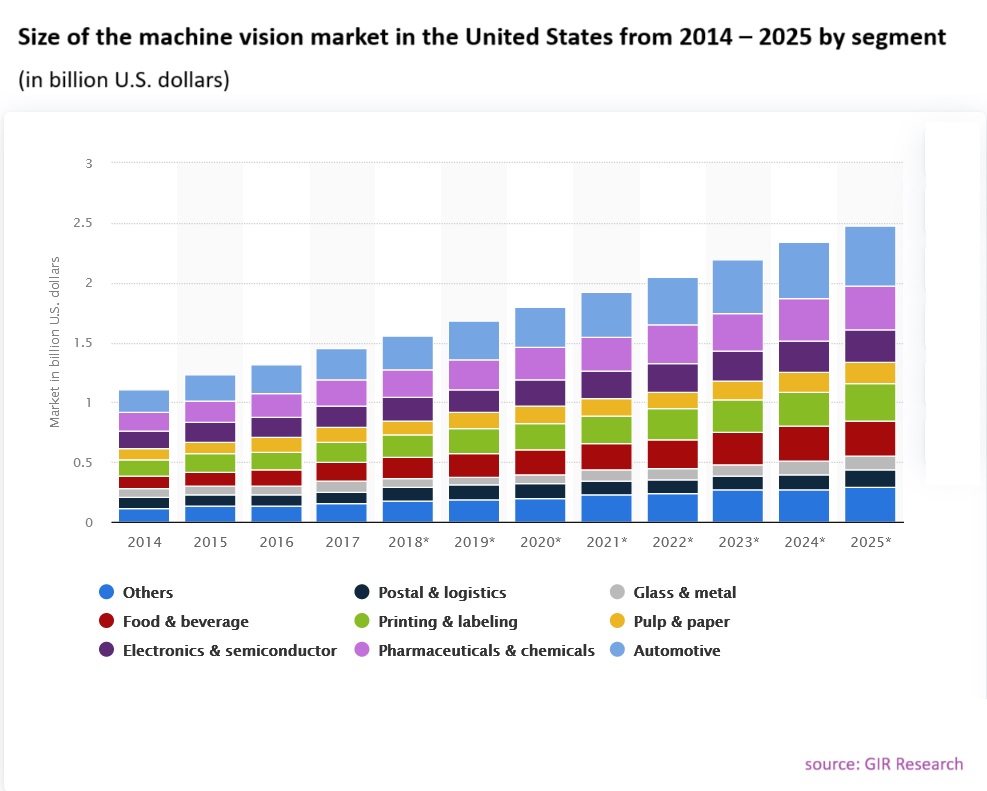Report Overview
- Understand the latest market trends and future growth opportunities for the Machine Vision Systems industry globally with research from the Global Industry Reports team of in-country analysts – experts by industry and geographic specialization.
- Key trends are clearly and succinctly summarized alongside the most current research data available. Understand and assess competitive threats and plan corporate strategy with our qualitative analysis, insight, and confident growth projections.
- The report will cover the overall analysis and insights in relation to the size and growth rate of the “Machine Vision Systems Market” by various segments at a global and regional level for the 2010-2030 period, with 2010-2021 as historical data, 2022 as a base year, 2023 as an estimated year and 2023-2030 as forecast period.
Description:
- The global market for Machine Vision Systems estimated at US$10.7 Billion in the year 2022, is projected to reach a revised size of US$15 Billion by 2030, growing at a CAGR of 4.4% over the period 2022-2030.
- Hardware, one of the segments analyzed in the report, is projected to record 4% CAGR and reach US$8.1 Billion by the end of the analysis period. Taking into account the ongoing post pandemic recovery, growth in the Software segment is readjusted to a revised 4.8% CAGR for the next 8-year period.
- The Machine Vision Systems market in the U.S. is estimated at US$2.9 Billion in the year 2022. China, the world`s second largest economy, is forecast to reach a projected market size of US$3.2 Billion by the year 2030 trailing a CAGR of 7.3% over the analysis period 2022 to 2030. Among the other noteworthy geographic markets are Japan and Canada, each forecast to grow at 1.4% and 4.9% respectively over the 2022-2030 period. Within Europe, Germany is forecast to grow at approximately 2.3% CAGR.
MARKET DATA INCLUDED
- Unit Sales, Average Selling Prices, Market Size & Growth Trends
- COVID-19 Impact and Global Recession Analysis
- Analysis of US inflation reduction act 2022
- Global competitiveness and key competitor percentage market shares
- Market presence across multiple geographies – Strong/Active/Niche/Trivial
- Online interactive peer-to-peer collaborative bespoke updates
- Market Drivers & Limiters
- Market Forecasts Until 2030, and Historical Data to 2015
- Recent Mergers & Acquisitions
- Company Profiles and Product Portfolios
- Leading Competitors
The Machine Vision Systems Market Report Includes:
- In-depth exploration of the industry, encompassing definitions, classifications, and the industry’s interconnected structure.
- Examination of pivotal supply-side and demand trends.
- Detailed breakdown of both international and local products.
- Insight into historical volume and value dimensions, along with market shares of companies and brands.
- Five-year predictions regarding market trends and growth.
- A robust and transparent research methodology conducted within the country.
- A blend of qualitative and quantitative analysis, grounded in segmentation that considers economic and non-economic aspects.
- Provision of market value data (in USD Billion) for every segment and sub-segment.
- Geographical, regional, national, and state-wise analysis.
- A succinct overview of the commercial potential inherent in products, technologies, and applications.
- Company profiles of key market players operating within the product category.
- Descriptions of attributes and manufacturing processes.
- Segmentation based on type, application, end-users, regions, and other factors.
- Discussion about the current state, challenges, innovations, and future requirements of the market.
- Examination of the market based on application and product sizes: utility-scale, medium scale, and small-scale.
- Country-specific insights and analyses for major countries and regions.
- Coverage of historical context, pivotal industrial developments, and regulatory frameworks.
- Analysis of competitive movements, including agreements, expansions, new products, and mergers & acquisitions.
- Exploration of opportunities for stakeholders and a depiction of the competitive landscape among market leaders.
- Specialized coverage of significant global events, such as the Russia-Ukraine war, global inflation, China’s “zero-Covid” policy shift, supply chain disruptions, trade tensions, and the risk of recession.
- Evaluation of global competitiveness and market shares among key competitors.
- Presence assessment across various geographical markets: Strong, Active, Niche, Trivial.
- Online, interactive, peer-to-peer collaborative updates.
- Access to digital archives and the Market Research Platform.
- Complimentary updates for a two-year period.
Machine Vision Systems Market Reports Scope and Segments:
| Report Attribute | Details |
| Market size in 2022 | US$10.7 Billion |
| Market size forecast in 2030 | US$15 Billion |
| Growth Rate | CAGR of 4.4% from 2022 to 2030 |
| Base year for estimation | 2022 |
| Historical data | 2015 – 2022 |
| Forecast period | 2023 – 2030 |
| Quantitative units | Revenue in USD million and CAGR from 2023 to 2030 |
| Report coverage | Revenue forecast, company ranking, competitive landscape, growth factors, trends, DROT Analysis, Market Dynamics and Challenges, and Strategic Growth Initiatives
COVID-19 Impact, Market Growth Trends, Market Limiters, Competitive Analysis & SWOT for Top Competitors, Mergers & Acquisitions, Company Profiles, Product Portfolios Market Size, Market Shares, Market Forecasts, Market Growth Rates, Units Sold, and Average Selling Prices. |
| Segments covered | Technology, Type, Product, System, Platform, Application and Region |
| Regional scope | North America; Europe; Asia Pacific; Latin America; Middle East and Africa and rest of the world |
| Country scope | United States, China, Japan, Germany, India, United Kingdom, France, Brazil, Italy, Canada, South Korea, Australia, Russia, Spain, Mexico, Indonesia, Netherlands, Switzerland, Saudi Arabia, Turkey, Taiwan, Poland, Sweden, Belgium, Thailand, Austria, Nigeria, Argentina, United Arab Emirates, Iran, Norway, Israel, Ireland, Malaysia, Denmark, Singapore, Philippines, Pakistan, Finland, Chile, Vietnam, Greece, Czech Republic, Romania, Portugal, Peru, New Zealand, Hungary, Iraq, Bangladesh, Qatar, Kuwait, Ukraine, Egypt, Kazakhstan, Colombia, Angola, Algeria, Morocco, Slovakia, Oman, Puerto Rico, Ethiopia, Sudan, Kenya, Ghana, Dominican Republic, Myanmar, Tanzania, Ecuador, Belarus, Guatemala, Lithuania, Latvia, Sri Lanka, Nepal, Lebanon, Slovenia, Bahrain, Libya and others |
| Key companies profiled | Adimec Advanced Image Systems; Allied Vision Technologies GmbH; AMETEK Surface Vision; Atlas Copco AB; Basler AG; Baumer Group; BitFlow, Inc.; Cadence Design Systems, Inc.; Chromasens GmbH; Cognex Corporation; Crevis Co., Ltd.; Dalsa Corporation; Datalogic S.p.A.; Deci AI; Eko; FLIR Systems, Inc.; Hermary Opto Electronics Inc.; IDS Imaging Development Systems GmbH; IMAGO Technologies GmbH; Intel Corporation; ISRA VISION AG; ISVI Corporation; JADAK; JAI A/S; Keyence Corporation; Lenovo; LMI Technologies Inc.; Lumenera Corporation; Matrox Electronic Systems Ltd.; Microscan Systems, Inc.; MVTec Software GmbH; National Instruments Corporation; Nerian Vision Technologies; Omron Microscan Systems, Inc.; Optotune AG; Pleora Technologies Inc.; Qualitas Technologies Pvt Ltd; Raptor Photonics; Relation Therapeutics; Ricoh Company, Ltd.; SICK AG; Sony Semiconductor Solutions Corporation; Stemmer Imaging AG; Teledyne DALSA; Teledyne FLIR LLC; Teledyne Princeton Instruments; Teledyne Technologies Inc.; Texas Instruments; TKH Group; Tordivel AS; Toshiba Corporation; USS Vision LLC; Vision Components GmbH; Vitronic Machine Vision LTD; Xenics NV; Zebra Technologies Corp and others |
| Customization scope | Free report customization (equivalent up to 20 analyst’s working days) with purchase. Addition or alteration to country, regional & segment scope. |
| Report Format | PDF, PPT, Excel & Online User Account |
Global Machine Vision Systems Market Report Segmented by:
Machine Vision Market by product:
- PC-based machine vision system
- Embedded Systems machine vision system
- Smart camera-based machine vision system
Machine Vision Market by deployment:
- General
- Robotic cells
Machine Vision Market by component:
- Hardware
- Camera
- Optics
- Frame grabber
- Processors
- Lighting
- Software
- Others
Machine Vision Market by end-user industry:
- Automotive
- Consumer electronics
- Electronics & semiconductors
- Printing
- Metals
- Wood & paper
- Food & packaging
- Rubber & plastic
- Pharmaceuticals
- Glass
- Machinery
- Solar panel manufacturing
- Textile
Machine Vision Market, by region:
- North America
- Europe
- Asia Pacific
- Latin America
- Middle East & Africa
- Rest of the World
Top Companies Covered in Global Machine Vision Systems Market Report:
| Adimec Advanced Image Systems | Matrox Electronic Systems Ltd. |
| Allied Vision Technologies GmbH | Microscan Systems, Inc. |
| AMETEK Surface Vision | MVTec Software GmbH |
| Atlas Copco AB | National Instruments Corporation |
| Basler AG | Nerian Vision Technologies |
| Baumer Group | Omron Microscan Systems, Inc. |
| BitFlow, Inc. | Optotune AG |
| Cadence Design Systems, Inc. | Pleora Technologies Inc. |
| Chromasens GmbH | Qualitas Technologies Pvt Ltd |
| Cognex Corporation | Raptor Photonics |
| Crevis Co., Ltd. | Relation Therapeutics |
| Dalsa Corporation | Ricoh Company, Ltd. |
| Datalogic S.p.A. | SICK AG |
| Deci AI | Sony Semiconductor Solutions Corporation |
| Eko | Stemmer Imaging AG |
| FLIR Systems, Inc. | Teledyne DALSA |
| Hermary Opto Electronics Inc. | Teledyne FLIR LLC |
| IDS Imaging Development Systems GmbH | Teledyne Princeton Instruments |
| IMAGO Technologies GmbH | Teledyne Technologies Inc. |
| Intel Corporation | Texas Instruments |
| ISRA VISION AG | TKH Group |
| ISVI Corporation | Tordivel AS |
| JADAK | Toshiba Corporation |
| JAI A/S | USS Vision LLC |
| Keyence Corporation | Vision Components GmbH |
| Lenovo | Vitronic Machine Vision LTD |
| LMI Technologies Inc. | Xenics NV |
| Lumenera Corporation | Zebra Technologies Corp |
After Sales Support:
- Every updated edition of the report and full data stack will be provided at no extra cost for 24 months.
- Latest 2022 base year report.
- Free Updated edition of 2023 every quarter without any hidden cost.
- No user limitation for the report. Unlimited access within the organization.
- Unrestricted post-sales support at no additional cost
- Free report customization (equivalent up to 10 analyst’s working days) with purchase. Addition or alteration to country, regional & segment scope
- Global Industry Reports will support your post-purchase for a period of 24 months to answer any of your queries related to the following market and to provide you any more data needed, for your analysis.
- Option to purchase regional or selected Chapters from the report.
Key Questions Answered in Machine Vision Systems Market Report:
- How big is the machine vision market?
- Which is the potential market for machine vision in terms of the region?
- What are the opportunities for new market entrants?
- Which applications are expected to drive the growth of the market in the next six years?
- What is machine vision, and how does it work?
- What are the primary components of a machine vision system?
- What industries benefit the most from machine vision technology?
- How does machine vision contribute to quality control and inspection processes?
- What role does artificial intelligence (AI) play in machine vision systems?
- How does machine vision support automation in manufacturing and logistics?
- What are the latest trends in machine vision technology, such as 3D vision and deep learning?
- How can businesses select the right machine vision system for their specific needs?
- What are the key challenges faced by machine vision system users, and how can they be addressed?
- How is machine vision contributing to advancements in robotics and autonomous vehicles?
- What is the impact of machine vision on healthcare and medical diagnostics?
- How does machine vision enhance security and surveillance systems?
- What is the future outlook for machine vision technology in the era of Industry 4.0?
- How does machine vision contribute to sustainable and environmentally friendly practices in industries?
- What are the emerging applications of hyperspectral imaging in machine vision?
- How do machine vision systems address data privacy and security concerns?
- What are the cost considerations for implementing machine vision solutions?
- How is machine vision impacting agriculture and precision farming practices?
- What are the challenges and opportunities in machine vision for small and medium-sized enterprises (SMEs)?
- How can machine vision assist in defect detection and quality assurance in electronics manufacturing?
- What are the ethical considerations related to machine vision, especially in AI-driven applications?
- How can machine vision systems be integrated with existing production lines and processes?
- What are the educational and training requirements for professionals in the machine vision field?
- How does machine vision contribute to food quality inspection and traceability?
- What are the key considerations for ensuring the reliability and robustness of machine vision systems?
- How can businesses stay updated with the latest developments and innovations in the machine vision market?











